Schools workshops in collaboration with the Repertory Theatre, Birmingham, Monday 12th November 2012 - Thursday 22nd November 2012
If your school would like to book a workshop please contact The Repertory Theatre, Birmingham, 0121 236 4455
Wounded by Jenny Stephens, presented at TA Centre, Kings Heath 29 October – 10 November 2012
The battle of Passchendaele, or Third Ypres was emblematic of the futility and senseless butchery of the First World War. Due to an extraordinarily wet summer and the swampy terrain the battle is an illustration of the miseries of fighting in mud, where many soldiers drowned in the shell holes. Approximately 310,000 British men and 260,000 Germans lost their lives at the battle of Passchendaele, in the ‘war to end all wars’.
Julia Hyland, Outreach Officer and Medical Effects Make-up Artist will be presenting a number of workshops based around the play ‘Wounded’. Medical effects make-up will be used to illustrate life in the trenches during World War One. Participants will explore the dreadful effects of Mustard Gas, used for the first time in 1917 by the Germans and which resulted in terrible burns while Dysentery, Trench Foot, Typhus and epidemic disease killed more people than guns or shells where the total number of people killed was over thirty seven million.
Cosmetics of Ancient Egypt. Location: Birmingham Museum, 11th August 2012
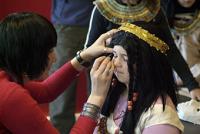 Cleopatra was the last queen of Egypt. Such was her beauty that she held the affection of not one but two political players on the world stage, Julius Caesar and Marc Antony.
Cleopatra was the last queen of Egypt. Such was her beauty that she held the affection of not one but two political players on the world stage, Julius Caesar and Marc Antony.
Learn about the cosmetics used in Ancient Egypt, the Ancient Near East and Minoan Greece with Julia Hyland, Medical Effects make-up artist and Outreach Officer for the History of Medicine Unit, University of Birmingham. The talk and demo is aimed at adults and older interested children.
This talk took place in the Waterhall - please note the exhibition Pharaoh: King of Egypt will be showing in the Gas hall over the summer and this ticket does not include entrance to the exhibition.
---------------------------------------------------------------------
Unhealthy Histories with Julia Hyland, Medical Effects Make-up and Outreach Officer, University of Birmingham
Hampton Court Palace, London. Monday 18th June 2012 at 6.30pm – 8pm. 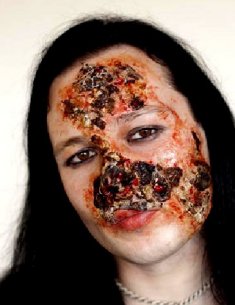 There were two sides to life at the court of Charles II, the glamorous elegance of fashionable court life, alongside the debauched reality of 17th-century behaviour. Throughout these hedonistic times, syphilis was widespread and its effects devastating. Many who pursued the libertarian lifestyle a little too enthusiastically succumbed to the disease, their reputations destroyed.
There were two sides to life at the court of Charles II, the glamorous elegance of fashionable court life, alongside the debauched reality of 17th-century behaviour. Throughout these hedonistic times, syphilis was widespread and its effects devastating. Many who pursued the libertarian lifestyle a little too enthusiastically succumbed to the disease, their reputations destroyed.
Join Julia Hyland as she discusses this disease, its place in 17th-century history, its treatment and the stigma associated with it. Julia will bring the history of this disease to life through medical effects make-up. This visual presentation with audience participation will reveal how applying medical effects make up to a healthy individual can help them empathise physically and emotionally with the diseases of the past and stimulate debate into medical history and treatments.
Pepys wrote in his diary in March 1664 that his brother fell ill of the pox, and lamented that “if he lives, he will not be able to show his head – which will be a very great shame to me.”¹
1. A. Wear ‘Medicine in Early Modern Europe, 1500-1700’, in L. Conrad, V. Nutton, R. Porter and A. Wear (eds), The Western Medical Tradition, 800 BC to AD 1800 (2000) 215–362, 262.
---------------------------------------------------------------------
March 2012 - Following on from the success of last year’s ‘Boils Are Us’ event at Oxford Brookes, Julia has been exploring the gory history of plagues and disease in ‘Boils Are Us – reloaded’ at Oxford Brookes’ Science Bazarre
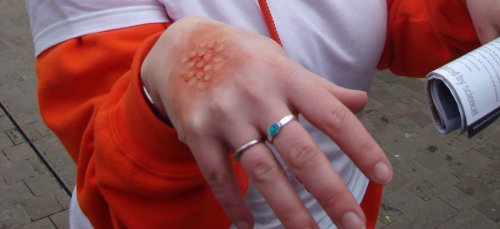
Three-way Podcast with Julia Hyland, Dr June Jones and volunteer students using ‘medical effects’make-up
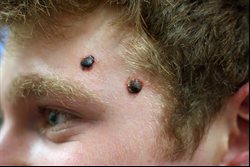 Julia Hyland has been using her ‘medical effects’ skills to make up volunteer Ethics and History of Medicine students with a variety of skin conditions (ringworm, psoriasis, eczema, chicken pox, kaposi’s sarcoma) as part of a joint research project with Dr June Jones into the under-diagnosis and misrepresentation of skin conditions on different skin tones. A three-way podcast has been produced in which Julia, June and the students will discuss the skin conditions ‘given’ to them, hopefully making for a lively and interactive session.
Julia Hyland has been using her ‘medical effects’ skills to make up volunteer Ethics and History of Medicine students with a variety of skin conditions (ringworm, psoriasis, eczema, chicken pox, kaposi’s sarcoma) as part of a joint research project with Dr June Jones into the under-diagnosis and misrepresentation of skin conditions on different skin tones. A three-way podcast has been produced in which Julia, June and the students will discuss the skin conditions ‘given’ to them, hopefully making for a lively and interactive session.
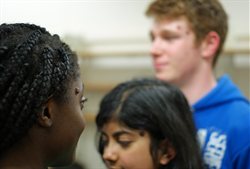 Last year, June supervised a student’s SP1 project on the lack of ethnically diverse images available for dermatologists and GPs. As part of their current diagnostic process, doctors can search a data base of images in dermatology, but our student found that only 2% of those images feature patients with darker skin tones. The risk therefore is that patients with darker skin tones may be under-diagnosed and, consequently, under-treated, or even mistreated. As our patient population in the West Midlands is particularly diverse, this is an especially relevant issue for Birmingham medical professionals.
Last year, June supervised a student’s SP1 project on the lack of ethnically diverse images available for dermatologists and GPs. As part of their current diagnostic process, doctors can search a data base of images in dermatology, but our student found that only 2% of those images feature patients with darker skin tones. The risk therefore is that patients with darker skin tones may be under-diagnosed and, consequently, under-treated, or even mistreated. As our patient population in the West Midlands is particularly diverse, this is an especially relevant issue for Birmingham medical professionals.
 Julia and June want to run CPD courses for GPs and dermatologists in training in order to provide opportunities to see what dermatological conditions look like on different skin tones. Before these courses run we invited a group of students to be made up to wear a variety of skin conditions applied as part of the podcast in order that Julia could practice and perfect her repertoire. They recruited students with a variety of skin tones as the conditions often present differently, sometimes radically so.
Julia and June want to run CPD courses for GPs and dermatologists in training in order to provide opportunities to see what dermatological conditions look like on different skin tones. Before these courses run we invited a group of students to be made up to wear a variety of skin conditions applied as part of the podcast in order that Julia could practice and perfect her repertoire. They recruited students with a variety of skin tones as the conditions often present differently, sometimes radically so.
Julia Hyland Medical Effects Makeup
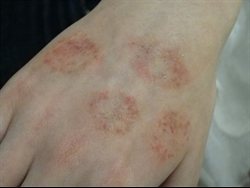 |
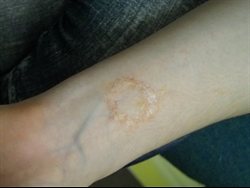 |
International skin conference: Scratching the surface: the history of skin, its diseases and their treatment’ University of Birmingham, 30th and 31st October 2010
 The History of Medicine Unit at the University of Birmingham held an International Skin Conference in October 2010. Sponsored by the Wellcome Trust and the Society for the Social History of Medicine the conference focused on skin and skin disease, including the history of venereal disease, cancer, leprosy, TB and industrial medicine.
The History of Medicine Unit at the University of Birmingham held an International Skin Conference in October 2010. Sponsored by the Wellcome Trust and the Society for the Social History of Medicine the conference focused on skin and skin disease, including the history of venereal disease, cancer, leprosy, TB and industrial medicine.
Industrial chemical wound
The conference brought together individuals working in very different sub-fields in the history of medicine over the past three centuries. The history of the senses; sight, smell and touch are also central to understanding skin disease and the way in which such diseases are experienced by practitioners, patients and the public historically.
Julia Hyland was on hand to give the delegates a variety of conditions including facial disfigurements, anthrax and industrial wounds.
Mini Medical School 17th November 2010
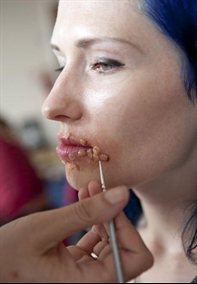 The Mini-Medical School is designed to give an insight into the training received as part of a Medical degree. People from all ages and backgrounds explore the background behind the medical training and discuss medical ethics, the role of the doctor and the history of medicine. The Mini-Medical school runs bi-annually, is informative and fun and provides a scientific background to improve the understanding of the human body, the doctor's role and health issues facing us today.
The Mini-Medical School is designed to give an insight into the training received as part of a Medical degree. People from all ages and backgrounds explore the background behind the medical training and discuss medical ethics, the role of the doctor and the history of medicine. The Mini-Medical school runs bi-annually, is informative and fun and provides a scientific background to improve the understanding of the human body, the doctor's role and health issues facing us today.
Once again Julia Hyland was involved in the practical session offering her unique range of skin conditions, syphilis anyone?
Syphilis
Birmingham History Day, University of Birmingham, 20th November 2010
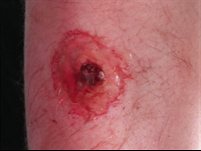 Birmingham History Day provided an opportunity to hear about recent publications, projects and heritage activities in the city. There were opportunities to listen to those who are drawing attention to local history. Introduced by Dr Malcolm Dick, University of Birmingham, the day drew attention to recent publications: Ted Rudge described his latest publication on Diptheria
Birmingham History Day provided an opportunity to hear about recent publications, projects and heritage activities in the city. There were opportunities to listen to those who are drawing attention to local history. Introduced by Dr Malcolm Dick, University of Birmingham, the day drew attention to recent publications: Ted Rudge described his latest publication on Diptheria
Diptheria
Birmingham’s Inner Districts through Time’ and Jan Bowman’s new book illustrated the history of the city with ‘This is Birmingham: discovering Birmingham’s hidden treasures’ local projects were highlighted: Dr Sian Roberts discussed the new work of Birmingham Archives and Heritage, Henrietta Lockhart gave us a preview of how the new History Galleries at Birmingham Museum are taking shape and Michael Wood drew attention to a series of videos has filmed on the history of the workshops and factories that were once part of the city's manufacturing heritage.
At the end of the day, Julia Hyland, History of Medicine Unit at the University of Birmingham, will brought ‘disease history to life with medical/moulage make-up’ This visual presentation and audience participation revealed how applying medical effects make-up to a healthy individual could help them empathise with some of the diseases, ailments and injuries of the past.